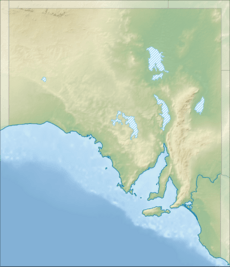Buckaringa Sanctuary facts for kids
Quick facts for kids Buckaringa SanctuarySouth Australia |
|
|---|---|
| Nearest town or city | Quorn |
| Area | 20 km2 (7.7 sq mi) |
| Managing authorities | Australian Wildlife Conservancy |
| Website | Buckaringa Sanctuary |
| Footnotes | Coordinates |
Buckaringa Sanctuary is a special nature reserve in the southern Flinders Ranges of South Australia. It covers about 20 square kilometers (that's 20,000,000 square meters!). The sanctuary is located about 30 kilometers north of a town called Quorn. The Australian Wildlife Conservancy (AWC) owns and takes care of this important area.
Contents
History of Buckaringa
Buckaringa was once a large farm, used for sheep and growing crops. This started in the 1880s and continued until 1990. In the early 1990s, it became a wildlife reserve. The Australian Wildlife Conservancy (AWC) bought it in 2002. Since then, they have worked hard to protect its unique wildlife.
Landscape and Climate
Buckaringa Sanctuary has a mix of different landscapes. You'll find rocky ridges and plains with thin soil. There are also steep-sided gorges with many cracks, caves, and piles of fallen rocks. These gorges were formed by streams cutting through the hills.
The climate here has cool winters and hot summers. It's a dry area, getting about 329 millimeters of rain each year.
Ecosystems and Habitats
Buckaringa is home to several types of natural environments. These include grassy areas called hummock grassland. There are also areas with Acacia shrubs and low woodlands. Some parts have northern cypress pine and mallee scrub. Along the creeks, you can find strips of river red gum woodland.
Animals and Plants
Scientists are still learning about all the plants and animals at Buckaringa. So far, they have found 60 different types of birds and four kinds of mammals. The AWC regularly checks the area to map out where different plants grow.
Birds of Buckaringa
Many interesting birds live here. You might spot huge wedge-tailed eagles soaring high above. There are also emus, sulphur-crested cockatoos, and fast peregrine falcons. Other birds include the colorful sacred kingfishers and blue-winged parrots.
Mammals of Buckaringa
The sanctuary is home to four main mammal species. These are the western grey kangaroo, the red kangaroo, the euro, and the yellow-footed rock-wallaby.
Buckaringa is very important for the yellow-footed rock-wallaby. It has one of the largest groups of these special wallabies. Protecting them is the main goal of the sanctuary.
Threatened Animals
The yellow-footed rock-wallaby is a very important animal here. It is listed as 'vulnerable'. This means it could become endangered if we don't protect it. These wallabies are fawn-grey with white undersides. They have a white cheek stripe, orange ears, and a rich brown stripe down their back. Their legs and feet are bright yellow, and their tails are orange-brown with dark rings.
The blue-winged parrot is also listed as 'vulnerable' in South Australia. The male parrots are olive-green with a small yellow face patch. They have a thin blue line above their eyes and bright yellow chests. Their wings are a deep royal blue. Females are usually duller in color. These parrots live in woodlands, forests, and even farmlands.
The peregrine falcon is listed as 'rare' in South Australia. This large, strong bird is known for its incredible speed. It has a steel-grey back, a black head, and a white collar. Peregrine falcons prefer open areas with gorges and cliffs. These places offer good spots for nesting near water.
Environmental Challenges
Sadly, many Australian mammals have disappeared over the last 150 years. A big reason for this is changes to their habitat. This happens when land is used for farming or grazing animals. Another major problem is introduced animals like foxes and goats.
Foxes and cats hunt native animals, especially ground-feeding birds and mammals. Goats compete with native animals, like the yellow-footed rock-wallaby, for food. This means the wallabies might have to search for food in less safe areas. This makes them more likely to be hunted by foxes.
Habitat loss and breaking up natural areas also harm wildlife. When small groups of animals are cut off from others, they are at a higher risk of disappearing.
Sanctuary Management
The Australian Wildlife Conservancy (AWC) works hard to protect the animals and plants at Buckaringa. Their main goal is to protect the yellow-footed rock-wallaby.
The AWC team has several projects to help:
- They remove introduced animals like goats, rabbits, cats, and foxes. For example, they have removed over 1000 goats.
- They have built a 23-kilometer goat-resistant fence around the sanctuary.
- They work to stop soil erosion.
- They restore native plants and natural springs.
Studies have shown that controlling foxes and goats helps the yellow-footed rock-wallaby population grow. The AWC's efforts are creating a much safer home for these special wallabies. The number of yellow-footed rock-wallabies at Buckaringa has varied, but the population has stayed strong, ranging from 300 to 1600 animals.


